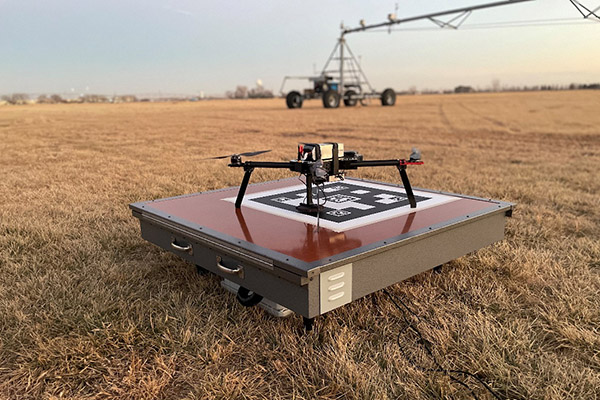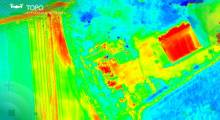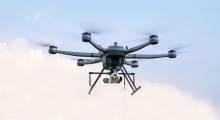As drones for commercial and industrial use take on longer-range missions, the need to easily recharge and transfer large amounts of data has become more acute. WiBotic Inc. today announced PowerPad Pro, a system designed to wirelessly charge drones and transfer flight data, images, and video.
“PowerPad Pro enhances drone functionality for our partners working in environments where autonomous or semi-autonomous operations are a priority,” stated Ben Waters, co-founder and CEO of WiBotic.
“We designed it as a flexible solution for those who either already own and operate drones—and have their own infrastructure in place—or those who are looking for a more cost-effective option for fully autonomous operations,” he added. “PowerPad Pro can be used as a stand-alone landing platform, or it can be integrated into any number of enclosures and form-factors such as trailers, sheds, or even truck beds.”
WiBotic provides wireless charging and power-optimization systems for the rapidly growing ecosystem of aerial, mobile, and marine robots. The Seattle-based company said its technologies can help maximize the uptime of robot fleets, and it works with customers in a variety of industries, as well as with the MassRobotics interoperability standard.
“Since we started in 2015, we focused on the broad automation sector—drones, mobile robots, and more recently, ASRS and semi-autonomous carts,” Waters told Robotics 24/7. “We started by selling charging hardware to companies building drone-in-a-box systems and saw great challenges in precision landing.”
As the drone industry pivoted from consumer markets to industrial applications such as remote inspection, it had to overcome the Federal Aviation Administration's restrictions on beyond visual line-of-sight (BVLOS) flights, he recalled. However, changes in FAA regulations and increasing demand for infrastructure and other data are increasing drone demand, Waters said.
PowerPad Pro provides autonomous charging
While many outdoor chargers use robotic arms to reposition drones for contact-based charging upon landing, such mechanical parts require extra maintenance, noted Waters. PowerPad Pro is sealed to the elements and moves the transmission coil internally for wireless charging and data transfer.
PowerPad Pro allows different types of uncrewed aerial vehicles (UAVs) to share a common platform and be deployed across large areas, said WiBotic. The company built its own hardware and software has been piloting the system for the past year.
“The onboard charger is only 100 to 200 g [3.5 to 7 oz.],” Waters said. “Any drone equipped with can land on the PowerPad Pro, and we're working on a reference platform to show how small it can be, but even a larger drone could use it.”
In addition, PowerPad Pro includes compute capability for programmable voltage and current. This can extend battery lifespan and reduce the the need for costly battery replacements and maintenance, claimed WiBotic.
Wireless data transfer to improve UAV missions
While PowerPad Pro recharges a UAV's battery, it can also wirelessly download flight and sensor data to its industrial computer. It can process that data locally or transmit it to a central location with 4G LTE or long-range data backhaul radios, said WiBotic.
Traditionally, drone operators had to swap out SD cards, which would fill up quickly with images, video, and other data that still required processing, noted Waters. He said the ability for remote operators to upload flight plans or monitor flights in real time will improve the safety and flexibility of missions.
“Most companies wanted to do inspections in remote areas, but they could only gather a couple of gigabytes of high-res video and photos and couldn't communicate over one bar of LTE,” Waters explained. “We're working on partnering with cellular companies on private LTE networks and have incorporated a third-party product for backhaul.”
“Our own API makes PowerPad Pro easy to integrate, and we have 1 TB of storage in the pad for edge computing,” he said. “A customer could even run Azure or AWS cloud-based tools to analyze imagery locally on the box versus sending tens of thousands of gigabytes of data.”
“We hope that the PowerPad Pro can act as a platform for other people to run their software on, such as data analytics and mission planning across a bunch of drones,” added Waters. “We hope we can host and help expand their markets and operations in the field.”
Multiple industries could benefit from new tech
In its press release, WiBotic said that PowerPad Pro's combination of wireless data transfer and autonomous charging will “dramatically” enhance drone operations across the following industries:
- Energy and utilities: Utility operators need data from infrastructure inspection every day – not once or twice a year. Permanently deployed UAVs with the ability to fly multiple repetitive missions, using one PowerPad Pro or a series of them over long distances, are critical for reducing inspection costs while increasing inspection frequency.
- Construction: Remotely monitoring construction sites provides innumerable benefits in terms of safety, build quality and owner/builder/subcontractor relations. However, most construction data is extremely high bandwidth and getting it to engineers and project managers at remote locations is extremely difficult without a solution like PowerPad Pro.
- Defense: Drones are frequently equipped with high-resolution cameras, infrared sensors and other advanced imaging equipment that gather terabytes of data. In a combat zone, however, it’s extremely dangerous to leave a protected vehicle to swap batteries or retrieve the SD cards that contain that data. A fully autonomous platform like PowerPad Pro ensures the warfighter remains protected while he or she gathers intelligence on enemy movements.
- Agriculture: UAVs have made monitoring thousands of acres of farmland easier than ever before – but that’s not to say it’s easy. Drones still have limited flight time and limited onboard data storage. A network of strategically placed PowerPad Pros solves this problem by providing charging stations across the entire farm and automatic backhaul of data to the farm HQ where it can be put to immediate use, said WiBotic.
“Some companies in agriculture, energy, or utilities have constraints on owning versus leasing,” added Waters. “We're flexible.”
“One question we get from everyone is whether the pad can just sit out there,” he said. “It's not a hangar, and since nobody is going straight from piloted to fully automated BVLOS inspections, the PowerPad Pro is an entry point. We are working on variants of a hangar, which has to be inexpensive, deployable at scale, and secure.”
WiBotic partners see utility of PowerPad Pro
One of WiBotic’s first partners for PowerPad Pro is Valmont Industries Inc., an Omaha-based provider of techology for monitoring infrastructure such as transmission lines or water for agriculture.
“Valmont has been working closely with WiBotic and other partners to enhance our drone inspection capabilities,” said Angi Chamberlain, vice president of UAS (uncrewed aerial systems) technology solutions at Valmont.
“For the first time, PowerPad Pro provides a charging platform that works with any of the different UAVs we use,” she said. “Remote flight-plan uploads and automated sensor data downloads also allow us to perform inspections on a moment’s notice at any location where the platform is deployed.”
Wibotic also announced that BlueHalo is offering the BlueHalo Intense Eye V2 (IE-V2) and E900 models with onboard units for charging and data offload.
“BlueHalo provides UAVs to both the commercial and defense sectors, with extensive experience in applications ranging from inspection and monitoring to intelligence, surveillance, and reconnaissance (ISR) missions,” stated Mary Clum, sector president and corporate executive vice president of BlueHalo. “There is a growing demand for permanently deployed and remotely controlled UAVs.”
“PowerPad Pro has given us a single, reliable tool to integrate autonomous charging and data offload capabilities into our UAV platforms, allowing us to offer new solutions and better support critical customer missions,” she said.
WiBotic plans to display PowerPad Pro at AUVSI Xponential 2023 from May 8 to 11 in Denver.
About the Author
Follow Robotics 24/7 on Linkedin
Article topics
Email Sign Up

















